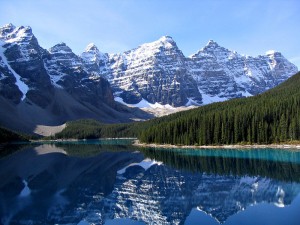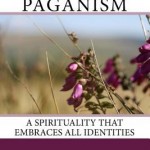Metaphors for religion are tricky things, especially when we try to stretch them and make them work too hard by trying to turn them into analogies. One very popular metaphor for explaining religious diversity is the idea that we are all walking different paths up the same mountain. However, many people are coming to believe (myself included) that we are in fact all walking up different mountains.
I had noted down the title of this post, and not got into writing it yet, when I saw that John Halstead has written an excellent post entitled “A mighty host respond”: Pagan unity through diversity which also suggests that we are in fact all walking up different mountains.

Mountains from left to right: Tonsa (3057 m), Mount Perren (3051 m), Mount Allen (3310 m), Mount Tuzo (3246 m), Deltaform Mountain (3424 m), Neptuak Mountain (3233 m). Photo by Gorgo.
The title of my post is inspired by the saying in the kink community, “Your kink is not my kink, but that’s OK” – in other words, diversity is acknowledged and celebrated.
I wonder if we actually each have our very own mountain – not just a different mountain for each tradition and religion and denomination, but personal mountains. Maybe our mountains are on the same mountain range, or on the same continent; maybe they are on different continents. And of course continents move around as the tectonic plates shift; new mountain ranges are created, new continents formed. The Pagan continent (like the mythical Atlantis) was submerged for a while, but now it has re-emerged, and we can explore it again, with its polytheist mountain range, its monist mountain range, its pantheist mountain range, and other geological formations. The Pagan continent also has magic portals or bridges to the Quaker realm, the Unitarian Universalist realm, the Taoist realm, the Buddhist realm, the Hindu realm, etc, or maybe whole regions of CUUPs people and Quaker Pagans, and Jewitches. Of course, being a Pagan sacred landscape, there are no centres, or centres everywhere, and no periphery (unless you want a bit of liminality). And there’s nothing to stop you exploring the other continents, or even settling for a while on one of them, as long as the inhabitants are friendly.
Indeed, who’s to say we are all climbing up mountains? Maybe some of us are exploring lush valleys, hanging out in the forest, taking a dip in the ocean, building a beautiful eco-village, or whatever takes your fancy. You can define your own journey, you can walk (or run or hop whilst whistling Dixie) on a predefined path, or discover your own bit of the lush Pagan continent. There is room for all. If I choose to decorate my sacred landcape with shrines to Oðinn, Ishtar, Shiva, and Shakti, and P Sufenas Virius Lupus chooses to decorate eir bit of landscape with shrines to Antinous, and someone else decorates theirs with shrines to the NeoPlatonic Divine Source, that’s all good.
And if you don’t like this metaphor for Pagan religions, it’s only a metaphor, so pick another one, or invent your own.
A while back, I wrote a meditation on religions as trees in a forest, which also emphasises the diversity of religious responses to the world:
The trees and the forest, by Yvonne Aburrow
As we sit in the quiet of the evening, breathing softly, each with our own particular concerns, let us be aware of our common humanity. Each of us has our own hidden wellspring of joy, our own experience of sorrow, our unique perspective on deities and their relationship with the world.
Let us celebrate the diversity of dreams and visions.
Think of the trees in the woods: each grows into its individual shape to fit its particular place and the events that have shaped its growth, but each is recognisable as one of a species: oak, birch, holly, maple, yew, beech, hawthorn.
Religions are like that too: each has its own unique characteristics, shaped by place, culture and history; but all of them have their roots in the fertile soil of human experience, and all seek the living waters of divinity.
Let us honour the beauty and diversity of religions in the world, whilst loving and cherishing our own particular visions and traditions, recognising that we too are rooted in our common humanity, all seeking the nourishment of the endless outpouring of love and wisdom that we call by many names, all of them holy.















